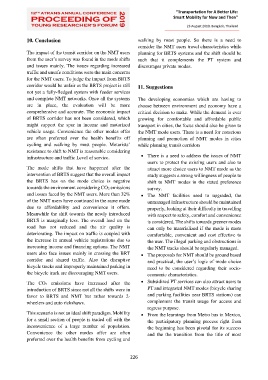Page 251 - Proceeding of Atrans Young Researcher's Forum 2019_Neat
P. 251
“Transportation for A Better Life:
Smart Mobility for Now and Then”
23 August 2019, Bangkok, Thailand
10. Conclusion walking by most people. So there is a need to
consider the NMT users travel characteristics while
The impact of the transit corridor on the NMT users planning for BRTS systems and the shift should be
from the user’s survey was found in the mode shifts such that it complements the PT system and
and issues mainly. The issues regarding increased discourages private modes.
traffic and unsafe conditions were the main concerns
for the NMT users. To judge the impact from BRTS
corridor would be unfair as the BRTS project is still 11. Suggestions
not yet a fully-fledged system with feeder services
and complete NMT networks. Once all the systems The developing economies which are having to
are in place, the evaluation will be more choose between environment and economy have a
comprehensive and accurate. The economic impact critical decision to make. While the demand is ever
of BRTS corridor has not been considered, which growing for comfortable and affordable public
might support the spur in income and motorized transport in cities, the focus should also be given to
vehicle usage. Convenience the other modes offer the NMT mode users. There is a need for conscious
are often preferred over the health benefits off planning and promotion of NMT modes in cities
cycling and walking by most people. Motorists’ while planning transit corridors
resistance to shift to NMT is reasonable considering
infrastructure and traffic Level of service. There is a need to address the issues of NMT
users to protect the existing users and also to
The mode shifts that have happened after the attract more choice users to NMT mode as the
intervention of BRTS suggest that the overall impact study suggests a strong willingness of people to
the BRTS has on the mode choice is negative shift to NMT modes in the stated preference
towards the environment considering CO2 emissions survey.
and issues faced by the NMT users. More than 32% The NMT facilities need to upgraded, the
of the NMT users have continued in the same mode unmanaged infrastructure should be maintained
due to affordability and convenience it offers. properly, looking at their difficulty in travelling
Meanwhile the shift towards the newly introduced with respect to safety, comfort and convenience
BRTS is marginally less. The overall load on the is considered. The shifts towards greener modes
road has not reduced and the air quality is can only be materialized if the mode is more
deteriorating. The impact on traffic is coupled with comfortable, convenient and cost effective to
the increase in annual vehicle registrations due to the user. The illegal parking and obstructions in
increasing income and financing options. The NMT the NMT tracks should be regularly managed.
users also face issues mainly in crossing the BRT The proposals for NMT should be ground based
corridor and shared traffic. Also the disruptive and practical, the user’s logic of mode choice
bicycle tracks and improperly maintained parking in need to be considered regarding their socio-
the bicycle track are discouraging NMT users. economic characteristics.
The CO2 emissions have increased after the Subsidized PT services can also attract users to
introduction of BRTS since not all the shifts were in PT and integrated NMT modes (bicycle sharing
favor to BRTS and NMT but rather towards 2- and parking facilities near BRTS stations) can
wheelers and auto rickshaws. complement the transit usage for access and
regress purpose.
This scenario is not an ideal shift paradigm. Mobility From the learnings from Metro bus in Mexico,
for a small section of people is traded off with the the participatory planning process right from
inconvenience of a large number of population. the beginning has been pivotal for its success
Convenience the other modes offer are often and the the transition from the title of most
preferred over the health benefits from cycling and
226

